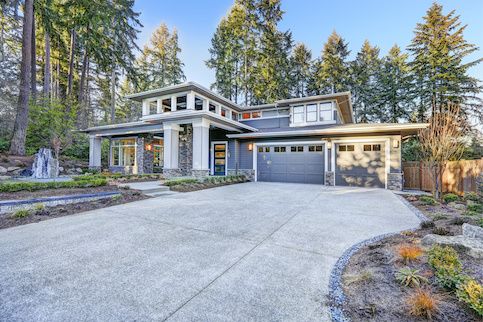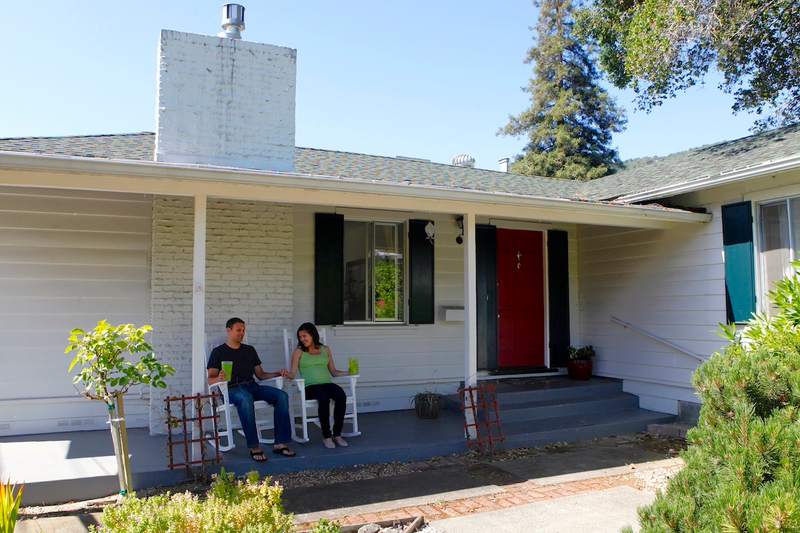When mortgage interest rates are higher, as they have been considered throughout all of 2023, adjustable-rate mortgages become more popular choices among homebuyers.
Unlike traditional fixed-rate mortgage loans, an adjustable-rate mortgage, often referred to as an ARM, features interest rates that can rise or fall over time. The benefit is that an ARM will boast an initial interest rate that is lower than what you’d get with other mortgages until your loan adjusts. However, once the initial period is over, your rate could increase or decrease, meaning you could end up paying more or less each month than what you might have spent on a fixed-rate mortgage payment.
ARMs could be a good way to save money in an environment of high interest rates. But there are potential pitfalls: Your mortgage payments could jump once your loan’s fixed period ends and its interest rate adjusts. Make sure you can afford the new payment that comes with your loan’s potentially higher interest rate.
Because of the fluctuating interest rates, ARMs require more planning than do traditional fixed-rate mortgages. If you are prepared to pay more, though, once your loan’s rate adjusts, an ARM could be a sound financial decision.
Adjustable-Rate Mortgage Definition
An adjustable-rate mortgage is a loan with an interest rate that will change throughout its life. You can take out an ARM in a variety of lengths, but some terms may be better than others in certain situations and markets.
But whatever term you choose, your ARM will come with two periods.
First, there’s the fixed-rate period. During this time, your loan’s interest rate will not change. The fixed period will vary depending on your loan, but most fixed periods last 3 – 10 years. The initial interest rate will typically be lower during this period than what you’d get with a fixed-rate loan. That’s the main selling point of an ARM: Homeowners will have a lower rate and lower monthly payments during this fixed period. But then, the potential savings depends on the market.
After the fixed period ends, your loan will enter its adjustable period, which will last until you pay off your loan, sell your home or refinance your mortgage. During this period, your interest rate will adjust according to whatever economic index it’s tied to. Usually, your interest rate will rise once the fixed period ends, which will also cause your monthly mortgage payment to increase.
How often your ARM’s interest rate adjusts varies depending on the type of loan you’ve taken out. Most ARMs, though, adjust once a year, meaning that your loan’s interest rate can only rise or fall once every year throughout the adjustable period.
Key Differences Between An ARM Vs. A Fixed-Rate Mortgage
The biggest difference between an adjustable-rate mortgage and a fixed-rate mortgage? An adjustable-rate mortgage has an interest rate that can rise or fall over time. In a fixed-rate mortgage, the interest rate never changes.
This means that the principal and interest portion of your monthly payment with a fixed-rate mortgage doesn’t change. However, your monthly payment could change slightly if you pay property taxes and homeowners’ insurance into an escrow account because those payments rise or fall.
The interest rate you get with a fixed-rate mortgage will be the same on the last day of your loan as it was on its first. This rate, though, will typically be higher than the initial rate you’d get with an adjustable-rate mortgage.
An ARM is more of a gamble than a fixed-rate loan. Borrowers hope that their loan’s interest rate doesn’t rise so much during its adjustable period that it negates the savings they’ll enjoy during its fixed period. Many homeowners take out ARMs when they plan on selling their home within 7 – 10 years. Others plan to refinance into fixed-rate loans when their ARMs are set to enter their adjustable periods.
See What You Qualify For
Buy A Home
Discover mortgage options that fit your unique financial needs.

Refinance
Refinance your mortgage to have more money for what matters.
Tap Into Equity
Use your home’s equity and unlock cash to achieve your goals.
How Does An Adjustable-Rate Mortgage Work?
An adjustable-rate mortgage is a home loan with a fixed interest rate for a set period. Once that period ends, the rate will adjust based on market conditions. It will do so multiple times throughout the remaining life of the loan.
How long your interest rate remains fixed and how often it adjusts depends on the type of ARM you take out.
A 7/1 ARM, for example, has a 7-year fixed period during which your interest rate won’t change. That’s the “7” part of the equation. Once those 7 years end, your interest rate will adjust once a year. That’s the “1” part of the ARM.
ARM Indexes
Indexes are economic indicators used to calculate the interest rate adjustments for adjustable-rate mortgages. The ARM loan’s index rate can increase or decrease at any time. These changes are measured in basis points, which are a special unit used for financial indexes.
Some of the most commonly used indexes with ARMs include:
- Secured Overnight Financing Rate (SOFR): Formerly the broad Treasuries financing rate, this index is the successor to LIBOR, short for the London Interbank Offered Rate. It measures the cost of borrowing cash on an overnight basis. To keep it simple, just know it’s a major factor in determining your variable rate at any given time.
- Constant maturity Treasury index: The 1-year constant maturity Treasury index is the most widely used in determining adjustments to the interest rates of adjustable-rate mortgages. The value is derived from risk-free securities called Treasuries.
- 11th District Cost of Funds Index (COFI): COFI is an index that reflects the average interest rate that the 11th Federal Home Loan Bank District pays for checking and saving accounts.
ARM Margins
Margin is a percentage point predetermined by your lender that remains the same throughout the life of the loan. It’s used to determine the interest rate for loans. Once the initial fixed-rate period ends on an adjustable-rate mortgage, the interest rate typically adjusts annually, and this new rate is determined by adding the index to the margin.
Although this usually causes your loan’s interest rate to increase, you do have some protection with an ARM: Rate caps limit how much your interest rate can increase each year and throughout the life of your loan.
ARM Caps
You might worry when taking out an ARM that your interest rate will rise so high that you won’t be able to afford your new monthly payment. That is a legitimate concern, and you need to make sure that your household budget can withstand any increase in your monthly mortgage payment.
ARMS come with caps, though, that limit how much your interest rate can rise, both during its first jump and throughout the life of your loan.
Here are the key ARM caps that can protect you from a soaring mortgage payment:
- Initial cap: This cap limits how much your interest rate can jump during the first time it adjusts. According to the Consumer Financial Protection Bureau (CFPB), this first cap is usually 2 or 5 percentage points. If your initial interest rate with your ARM is 6% and your initial cap is 2 percentage points, your interest rate can only jump to a maximum of 8% when your loan first leaves its fixed period.
- Periodic cap: This cap spells out how much the interest rate can increase in the adjustment periods that follow that initial adjustment. The periodic cap is often set at 2 percentage points, meaning that your loan’s interest rate can’t increase by more than 2% during each adjustment period.
- Lifetime cap: This cap limits how much your ARM’s interest rate can adjust in total throughout the life of your loan. The CFPB says that this cap is usually 5%, meaning that your loan’s interest rate can never increase by more than 5 percentage points during its entire life. If your ARM starts with an interest rate of 6%, a lifetime cap of 5% means that its rate could never rise past 11%.
The Different Types Of ARMs
Considering an ARM? This mortgage option comes in many types. And like all mortgages, you can adjust your term. You might consider taking out a longer-term ARM or a shorter-term one.
5/1 And 5/6 ARMs
- 5/1 ARM: In a 5/1 ARM, your interest rate will remain fixed for 5 years. After this period ends, your rate will adjust once every year.
- 5/6 ARM: The 5/6 ARM also comes with a fixed period that lasts 5 years. After this period ends, your interest rate will adjust every 6 months, or twice a year.
7/1 And 7/6 ARMs
The 7/1 and 7/6 ARMs are a good choice for those homeowners who want to stay in their homes a bit longer. They’ll have more years before their loans adjust.
- 7/1 ARM: With a 7/1 ARM, your interest rate will remain fixed for 7 years. It will then adjust once every year.
- 7/6 ARM: With the 7/6 ARM, your initial interest rate remains fixed again for 7 years. But after this period ends, your rate will adjust every 6 months.
10/1 And 10/6 ARMs
For an even longer fixed period, there are the 10/1 and 10/6 ARMs.
- 10/1 ARM: In a 10/1 ARM, your initial interest rate remains unchanged for a 10-year period. After these 10 years, your rate adjusts once every year.
- 10/6 ARM: With the 10/6 ARM, your rate remains fixed for 10 years and then adjusts every 6 months for the rest of your loan’s life.
As the market shifts and pricing changes ARMs might make more sense compared to the 30-year. However, it’s best to speak to a loan expert about your loan options.
Find out if an ARM is right for you.
See rates, requirements and beneifts.
Adjustable-Rate Mortgage Pros And Cons
As with all loan types, ARMs come with negatives and positives.
ARM Loan Pros
- Low payments during the fixed-rate period: Because your ARM will usually come with an initial interest rate that is lower than what you’d get with a fixed-rate mortgage, your monthly payments will be lower during its fixed-rate period. This could lead to thousands of dollars in interest savings.
- A potential payment decrease: Depending on the performance of whatever economic index your ARM is tied to, your monthly payment might drop during an adjustment period. That’s because interest rates don’t only rise during adjustments, they could also fall. Be careful, though: It’s not easy to predict what the economy will do during the life of your loan, so it’s also challenging to predict whether your rate will rise or fall over time. It’s important to consider your budget and caps – and make sure you’d be able to pay up to the cap each month, just in case.
- Flexibility: Many homeowners choose ARMs if they know they’ll be selling their homes or refinancing their loans in the future. Say you take out a 7/1 ARM. You can enjoy the lower interest rate during this loan’s fixed period. Then, before the loan enters its adjustment period, you can refinance to a fixed-rate mortgage or sell your home.
ARM Loan Cons
- Payments that could rise: It’s more difficult to budget for ARM payments because you don’t know what your monthly payment will jump to after your loan’s fixed period ends. You should always make sure you can afford a higher mortgage payment. The odds are good that your interest rate will jump during its initial adjustment period.
- Interest rates likely changing: If you don’t like uncertainty, an ARM might not be for you. Your interest rate will almost certainly change – either once or twice a year depending on your ARM type — during your loan’s adjustment period, and you won’t be able to accurately guess at what this new rate will be.
- Prepayment penalties: Some ARMs come with prepayment penalties if you pay them off too early. This includes refinancing the loan or selling your home. Make sure that you won’t suffer any prepayment penalties if you plan to sell your home or refinance your ARM before it enters its adjustable period.
Adjustable-Rate Mortgage FAQs
Have questions about ARMs and how they work? That’s not surprising. These are more complex than traditional fixed-rate mortgages. Here are answers to some of the most common questions homeowners typically have about these loans.
What’s the difference between a fixed-rate mortgage and an adjustable-rate mortgage?
With a fixed-rate mortgage, your loan’s interest rate will never change. With an adjustable-rate mortgage, you start with an interest rate that is fixed for several years, often 5 – 10. After this fixed period ends, your loan’s interest rate will adjust, usually either once a year or every 6 months.
Will my mortgage payment rise with an ARM?
Probably. If your interest rate rises after your loan’s fixed period ends, your monthly payment will rise. In most cases, your rate will increase at least during its first adjustment period and might rise several times throughout the life of your loan.
Can I refinance an adjustable-rate mortgage?
Yes. Many homeowners refinance their ARMs before they enter their adjustable period. Most lenders require that you have at least 20% equity in your home before they approve you for a refinance. Equity is the difference between what you owe on your mortgage and how much your home is worth.
The Bottom Line
While an ARM isn’t right for every borrower, those looking for the lowest possible interest rate might benefit from applying for one of these loans.

Dan Rafter
Dan Rafter has been writing about personal finance for more than 15 years. He's written for publications such as The Washington Post, Chicago Tribune and Wise Bread.












